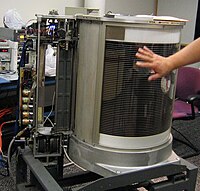
Photo from wikipedia
The ability to recover trace DNA from fired cartridge cases can help establish important leads regarding the handler of the ammunition. Over recent years, several DNA recovery techniques for fired… Click to show full abstract
The ability to recover trace DNA from fired cartridge cases can help establish important leads regarding the handler of the ammunition. Over recent years, several DNA recovery techniques for fired ammunition have been published. Three techniques of significant interest include tape lifting, direct PCR, and vacuum filtration. This study aimed to compare these to the swabbing method currently employed in our jurisdiction. Brass and nickel cartridges of five different calibres were spiked with 20ng of saliva and subject to DNA collection using all four DNA recovery methods. Unfired and fired cartridges were tested to examine the effects of firing. Swabbing recovered a greater quantity of DNA than vacuum filtration while no significant differences were found between swabbing and tape-lifting. The calibre of ammunition had no effect on DNA recovery. Firing significantly reduced DNA yield from nickel cartridges, while unfired brass cartridges returned less DNA than unfired nickel cartridges. PCR inhibition was not observed in any samples, although degradation indices suggested that most samples were slightly or moderately degraded. Analysis of profiles showed that swabbing and tape lifting resulted in greater numbers of alleles from fired nickel and brass cartridges compared to direct PCR. Samples from nickel cartridges were found to have a greater number of uploadable profiles than samples from brass cartridges. In addition, three mixed profiles were obtained from the single source spiked cartridges as well as evidence of pre-existing DNA on uncleaned cartridges and contaminating alleles on cleaned cartridges. Our results suggest that tape-lifting can be a suitable alternative to swabbing, but that caution must be taken when interpreting profiles from fired cartridge cases as small amounts of DNA not associated with the handling of the cartridges may be present.
Journal Title: Forensic science international
Year Published: 2020
Link to full text (if available)
Share on Social Media: Sign Up to like & get
recommendations!